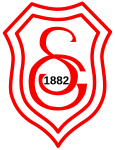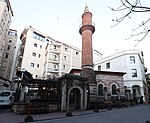Italian Synagogue (Istanbul)
1931 establishments in TurkeyAsian synagogue stubsBeyoğluEuropean synagogue stubsGolden Horn ... and 8 more
Gothic Revival architecture in TurkeyGothic Revival synagoguesItalian-Jewish diasporaItalian diaspora in EuropeItalki Jews topicsSynagogues completed in 1931Synagogues in IstanbulTurkish religious building and structure stubs

The Italian Synagogue, also known as Kal de los Frankos, is a synagogue located north of the Golden Horn in Istanbul, Turkey. The synagogue was established by the Italian Jewish community of Istanbul, (Comunità Israelitico-Italiana di Istanbul), in the 19th century. In 1931 the original building was demolished and a new synagogue was built in its place.
Excerpt from the Wikipedia article Italian Synagogue (Istanbul) (License: CC BY-SA 3.0, Authors, Images).Italian Synagogue (Istanbul)
Şair Ziya Paşa Caddesi,
Geographical coordinates (GPS) Address External links Nearby Places Show on map
Geographical coordinates (GPS)
| Latitude | Longitude |
|---|---|
| N 41.025555555556 ° | E 28.9725 ° |
Address
İtalyan Sinagogu (Kal de los Frankos)
Şair Ziya Paşa Caddesi
34421 (Bereketzade Mahallesi)
Türkiye
Open on Google Maps







